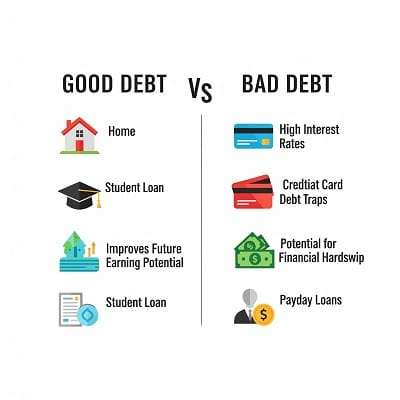Navigating Debt: How To Make It A Financial Friend, Not A Foe
Debt is a term that has the tendency to create mixed feelings—some perceive it as a stepping stone to progress, while others consider it a financial setback. Whether one is hoping to purchase a house, venture into business, or cover education expenses, it can be a deciding factor. But is it your friend or enemy? Here, in this blog, we’ll demystify the double-edged nature of it, discuss its advantages and dangers, and offer practical tips to guide you in making sound money decisions. Let’s get started!
What Is Debt, Really?
It is a borrowed money from a lender with the intention to repay it, usually with interest. It may take different names—home loan, credit card debt, personal loan, or study loan. The debt may unlock opportunities, but misusing it can result in financial pressure.
Debt as a Friend: Unlocking Opportunities
When used wisely, It can be a powerful tool to achieve your goals. Here’s how:
- Building Wealth Through Leverage: It allows you to invest in assets that appreciate over time, like real estate or
- Fueling Business Growth: A well-planned business loan can fund equipment, inventory, or marketing, driving revenue and growth
- Access to Education: Student loans make higher education accessible, paving the way for better career opportunities and higher earning potential.
- Emergency Safety Net: Personal loans or credit cards can act as a lifeline during unexpected expenses, like medical emergencies or car repairs, helping you avoid dipping into savings.

Types of “Friendly” Debt
| Type | Purpose | Potential Benefit | Example |
| Home Loan | Buy Property | Asset appreciation | Mortgage for a house |
| Student Loan | Fund Education | Higher earning potential | Loan for degree program |
| Business Loan | Start/Expand Business | Revenue growth/Scalability | Loan for inventory |
| Personal Loan | Cover Emergencies | Financial Flexibility | Loan for medical bills |
Debt as a Foe: The Dark Side
- High-Interest Traps: Credit card loan or payday loans often come with sky-high interest rates (20-40% annually). Carrying a balance can lead to a spiral
- Over-leveraging: Borrowing beyond your repayment capacity can strain your finances.
- Lifestyle Inflation: Using It to fund a lavish lifestyle—think luxury vacations or designer clothes—can erode your financial stability. This type of debt rarely offers long-term value.

Types of “Risky” Debt
| Type | Risk Factor | Potential Consequence | Example |
| Credit card debt | High interest rates (20-40%) | Debt spiral, increased costs | Unpaid shopping bills |
| Pay day Loan | Extremely high interest | Financial distress, default | Short-term cash advance |
| Personal Loan | High interest rates 11.90% to 24.00% | Missed payments, credit score damage | Loan for luxury purchases |

Striking the Balance: How to Make Debt Work for You
To ensure it remains your friend, follow these practical tips:
- Borrow with Purpose: Only take it for investments that offer long-term value, like education or property. Avoid borrowing for depreciating assets or fleeting pleasures.
- Understand Interest Rates: Compare loan terms and prioritize low-interest options.
- Create a Repayment Plan: Before borrowing, calculate your debt-to-income ratio (DTI). A DTI below 30% is ideal, ensuring you can comfortably manage repayments.
- Build an Emergency Fund: Maintain a savings buffer (3-6 months of expenses) to avoid relying on it during emergencies
- Pay More Than the Minimum: For credit cards or loans, paying only the minimum prolongs debt and increases interest costs. Pay extra whenever possible to clear It faster.

Conclusion: Master Your Debt, Don’t Let It Master You
It may be a tool when strategically applied to create riches, pay for education, or expand business. It may become an enemy if not properly controlled, as it creates financial anxiety and long-term problems. Borrowing intentionally, being aware of terms, and making repayment a priority, you can maximize the power of It while sidestepping its peril.

